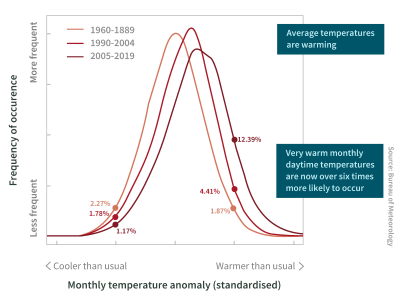Climate Change in Australia
Climate information, projections, tools and data
Step 3: Analyse Climate Risk
OVERVIEW

Figure 1 Small mean temperature changes can dramatically change the incidence of very high temperatures. In this example, an increase of less than 1 °C in mean temperature leads to a sixfold increase in monthly days 2 °C higher than average.
Our future climate will be different from that of the past, and the impact of weather on a future energy system in a future climate will become increasingly significant. For example, Figure 1 shows that a small shift in mean temperatures will result in a large shift in the frequency of higher than usual temperatures, an important hazard for electricity infrastructure.
The ESCI Climate Risk Assessment Framework (Figure 2) provides a standard process and guidance which allows risk related to future climate to be consistently integrated into sector planning and risk modelling.
The ESCI project data has focused on four climate hazards:
- rising temperatures
- increasing intensity of bushfire weather
- increased incidence of severe convective winds
- increased variability of dam inflows
Information on how these hazards are likely to change can be provided with medium to high confidence (except for severe convective winds). Step 3 of the climate risk assessment framework recommends using the relationship between performance and historical weather conditions, established in Step 2 , to analyse performance in a future climate. This is covered in the section ‘Quantified risks ’.
For some climate hazards there is a high level of uncertainty in the projections, either because climate models do not agree on the trends or the hazards are rare (e.g. extreme and compound events). Despite these limitations, there is information available on these hazards that can provide an indication of whether the risk they present is likely to be material in future. Information on how to assess the risk from these hazards is provided in the section ‘Unquantified risks ’.

Figure 2. The ESCI Climate Risk Assessment Framework.
Note: Climate projections are derived from climate models that have limitations. The numerical precision of these data must not be confused with accuracy. Downscaled projections should be considered indicative, rather than precise, based on the best available information. Where possible, uncertainties have been estimated and confidence ratings have been provided. Where the climate risk assessment suggests a significant risk, or where the risk is assessed for a high value investment, the advice of climate experts should be sought.



